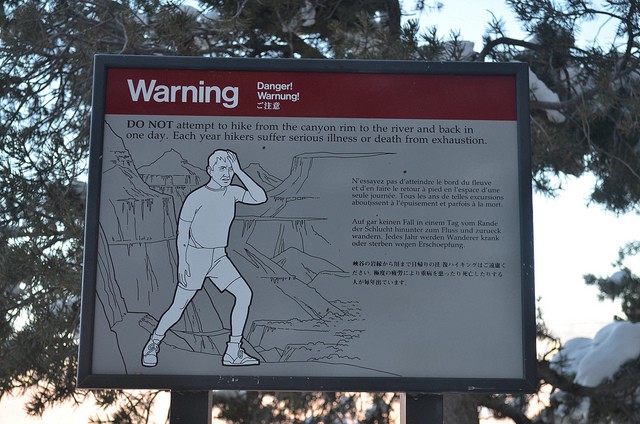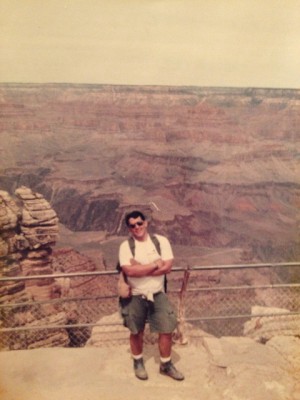Hiking The Grand Canyon In A Day
by John Ore

Signs posted at the rim of the Grand Canyon warn you not to attempt to hike to the river and back in one day: it’s too strenuous, and you need to be prepared with food and a gallon of water per person. Apparently, there are several deaths (especially in the summer months) and 250 rescues made each year, so the National Park Service is serious about this. Typical warnings exhort: “DO NOT attempt to hike from the rim to the river and back in one day, especially May to September.”
I arrived at the Grand Canyon in late March. It was Spring Break, 1990.
A couple of fraternity brothers and I had decided to drive from Berkeley to the Grand Canyon, stopping and camping along the way as time and our whims permitted. A loose itinerary included Death Valley, Las Vegas, the Natural Bridges National Monument, and really anywhere else that looked at all interesting in our Thomas Guides. “Camping” was a bit of a relative term: we threw everything we could think of in the back of a small Toyota pickup without much thought given to space or utility: we had a huge family tent that looked like it was from the 1970s, overstuffed sleeping bags, army surplus backpacks, boda bags and canned beans, and, of course, beer. (I later found out that someone had brought a 9mm handgun.) Three of us jumped into an old Volkswagen Scirocco and followed the other two in the pickup off into the Sierras one evening only to discover that our preferred route across the mountains was still closed for the winter. We made the detour and drove through the night. Around 6 the next morning, we watched the sun come up near Mono Lake as we pitched the tent in a deserted campground. We dozed off for a few hours, but woke up when a park services ranger came by to oust us. It turned out the campground was closed for the season. This would, it turned out, become a theme of the trip.
***
Three days later, we arrived at the Grand Canyon under darkness, resigned to having to wait until morning to actually see it. We’d camped at Furnace Creek in Death Valley, done a few half-assed day hikes, and stopped in the Arizona desert to fire off a few rounds from the 9mm (the ammo came from a Kmart somewhere, where we also bought some fishing licenses that we’d never use).
The South Kaibab Trail starts 7,260 feet above the Colorado River on the south rim of the Grand Canyon, and runs about 5 miles to the Phantom Ranch campground on the floor of the canyon. Three miles in, you’re still a mile above the river at Skeleton Point, where you are advised to turn around if day-hiking. From there, it’s a steep vertical descent to the river. Three of us — Scott, Jeff and I — decided that we were going to hike down to Phantom Ranch, spend the night at the bottom of the Grand Canyon, and hike out the next day. Our two other companions dropped us off at the trailhead, opting out of the hike.
We were just college jerks, ill-prepared and poorly outfitted for our expedition. It was late March, but there were still patches of snow here and there on the canyon rim. We were wearing shorts and t-shirts, maybe with a sweatshirt tied around our waist, each hauling a sleeping bag, canteen, and perhaps a can of baked beans. We didn’t even bring a tent.

Hiking down, the goal of our trip finally came into focus: as people say, you don’t quite believe the Grand Canyon is real because its scale is off the charts. It’s so huge you have a hard time believing what’s right in front of your eyes. It was a warm, partly cloudy day, and we were fueled by our enthusiasm and the sheer vastness of the canyon that was swallowing us. We set a leisurely pace, stopping to take pictures along the way, and eventually made it to the suspension bridge over the river by mid-afternoon. After a refreshing dip in the Colorado River, watching rafting tours drift by, we made our way to the Bright Angel campground to grab a campsite. Understandably more spartan than the crowded campground in the village at the canyon rim, Bright Angel was tucked into a small ravine off of the river on the way to Phantom Ranch, with small campsites roughly demarcated off of the trail. It was pretty empty. Perfect for an overnighter, we envisioned sleeping under the stars at the bottom of the Grand Canyon. We set up camp and started a small fire to cook with. Then a ranger came by.
***
There are three main “Corridor Use Areas” below the rim of the Grand Canyon, all of which require backcountry permits for camping. The Bright Angel campground is one of them. Apparently, people apply for permits weeks, months, even years in advance. With the benefit of the internet, you can discover this in about 5 minutes. With the benefit of hindsight, you could probably have discovered this by doing a tiny bit of research 20 years ago. As I said, we were just dumb-ass college kids. At today’s prices, it would have cost the three of us $25 total to camp at the bottom of the canyon overnight.
The ranger asked us for our permit, which of course was the first time we’d heard of such a thing. Naturally, we simply asked if we could buy a permit from him. This was an honest request; it didn’t even dawn on us to attempt a bribe, and we were naive enough to think that rangers sold permits like train conductors. His response was very matter-of-fact: you could only obtain permits at the rim of the canyon, they were absolutely required, and people waited months to get them. Then he told us we’d have to leave. Not just the campground, but the Grand Canyon. (As a result, by the age of 20, I’d officially been kicked out of the Sherman Oaks Galleria, the City of Beverly Hills, and now the Grand Canyon.)
It was about 5. We protested, using the day-hiking warnings as our defense. He told us we could rest, get some food and water in us, then hit the trail. We’d be fine, he said. We briefly considered finding someplace secluded along the river to hide out for the night, but we were so frustrated at having our Grand Canyon experience spoiled by bureaucracy that we just wanted the Hell out. Within an hour we were headed along the river to the Bright Angel Trail. We’d planned to use it as our exit the next day anyway, reasoning that it was less steep than the South Kaibab Trail and its trailhead was in the village, where our friends were camped. But it was also almost twice as long as the South Kaibab Trail. (My father would later remark: “I would have told the ranger to go screw himself, and make them bring in a helicopter if they wanted to arrest us.”)
Starting our ascent, I immediately knew it was going to suck. My knees were still shaky from the 5-mile-plus descent, I wasn’t in the best shape, and we had 9 miles to go. Uphill. At first, there was a sense of camaraderie, the three of us sort of shrugging our shoulders, viewing this as just another byproduct of our loosey-goosey approach to the trip, an adventure, and muttering about how fucked we were. After an hour or so, we fell silent and trudged along. Later, as dusk came, my legs started cramping up. Jeff and Scott would take turns pounding my quads and calves with their fists to try to loosen up the cramping muscles (and probably also out of frustration at my slow progress). Halfway up the trail, under darkness, we stocked up on water at the Indian Garden campground while I tried — in vain — to convince my march comrades that we could sneak into the campground and spend the night. Instead, we pushed on in the dark.
The worst part — well, one of them — about hiking in the dark was the sensation that you were walking in place, like on a treadmill. The trail and incline and switchbacks barely changed in the cones of our flashlights, and the lack of discernible progress was exacerbated by the dark mass of the rim just sitting there outlined against the starry sky: it never changed, never drew closer, and never went away. Several times I sank down on the trail — as much from desperation as fatigue. So we just stopped on the trail, lit an impromptu fire, and cooked our beans in the can to rest and break up the monotony. I’m sure this was illegal, but we didn’t care. I wanted to unroll my sleeping bag right there. Scott and Jeff just wanted out.
After five hours, we ran out of water, and our little unit of three fractured. Scott, convinced that he could find a shortcut to the top, took off straight up the hill despite our protests that he had one of our two working flashlights. We’d see his outline on a ridge, we’d yell “Scott!”, he’d reply “What?!?!?”, and we’d ask him what he was doing. No answer. Then we’d repeat the call-and-response with the same results. Eventually, we gave up. Jeff and I marched on, convinced Scott was going to fall off of a cliff with the keys to the pickup. 20 minutes later, I spotted a patch of snow glowing in the moonlight above the trail, and made a beeline for it (I was thirsty). Jeff started to scream and curse me, thinking I was taking off like Scott had — and because I had the only remaining flashlight.
***
Jeff and I would emerge at the Bright Angel trailhead at 12:30 am, about 6-and-a-half hours after we’d started hiking out of the Grand Canyon and more than 12 hours since we’d first glimpsed the canyon from the South Kaibab trailhead. We found Scott at the top, waiting for us. We were too tired to be pissed at him, and wandered into the Bright Angel Lodge where they gave us orange juice at the closed bar after listening to our story. We even managed to hitch a ride back to our friends’ campsite.
The next day, Scott, Jeff and I left the Grand Canyon as soon as we could. Our other two friends stayed, but we’d had enough. We headed towards Monument Valley, Utah; the three of us crammed into the cab of the pickup, dazed and sore. We set up camp alongside the road somewhere near Natural Bridges National Monument, convinced yet another ranger would come along to roust us. Upon looking at the map and discovering we were a two-day drive from Berkeley, we lost our resolve and started on the long drive home with nothing but an audio book about Abraham Lincoln and Pink Floyd’s Ummagumma on cassette. Both of which are super creepy to listen to while driving Route 50 through Nevada at 2 in the morning.
Previously in series: Portraits From A Cross-Country Road Trip, Fly Fishing The Universe and A Chat With A Person Who Has Been To Disney Parks 40 Times
John Ore hasn’t been back to the Grand Canyon since. Top photo courtesy of eGuide Travel.
